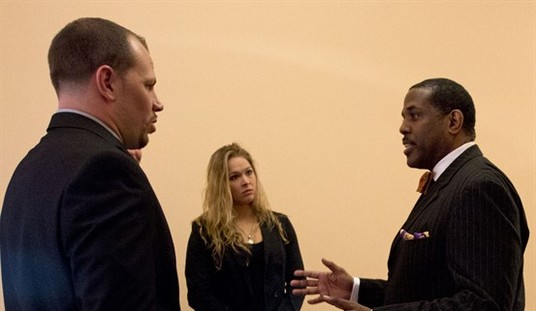A comment on Twitter asked: what must America’s enemies be thinking of its recent obsession with men becoming women, and white people becoming black? Even Jelani Cobb of New Yorker has begun to suspect that society has put its foot upon the staircase of madness.
On June 7th, Elinor Burkett published an Op-Ed in the Times expressing what she portrayed as a feminist’s reluctant skepticism about aspects of the transgender movement. She argued, in part, that the notion of men simply transitioning into women was equivalent to a white person darkening his or her skin and professing to be black. The example was meant as a reductio ad absurdum—but, less than a week later, Rachel Dolezal, the president of the Spokane, Washington, chapter of the National Association for the Advancement of Colored People and a professor of Africana studies, was unveiled as a white woman who has for some years presented herself and identified as black.
Cobb ultimately fights back the momentary worry and denies there anything really wrong. She decides that fabulism has a good side; that “our means of defining ourselves are complex and contradictory … but … remains vital.” However that may be, she is clearly right in seeing the trend cannot stop at Jenner and Dolezal. There are more “trans” things on the horizon, from trans-nationals who “identify” as Green Card holders to trans-realists who identify with their social media avatars. Recent events are just the first trickle of stones which precede an avalanche that is sure to follow.
Things are definitely drifting someplace, the question is where. Back in the 20th century, when it was still customary to fear insanity, Harvard University psychiatrist Walter Langer was asked by the OSS to analyze the mind of Adolf Hitler. They wanted to know where the Nazi dictator would finish up. Langer concluded — accurately as it turned out — that he would finish up in a gutter. Hitler, and the forces he led as a consequence, would simply refuse to accept there might be something wrong and continually double down on the original path. A Wikipedia summary of the report puts Langer’s findings this way:
As the war turns against him, his emotions will intensify and will have outbursts more frequently. His public appearances will become much rarer, because he’s unable to face a critical audience. … From what we know of his psychology, the most likely possibility is that he will commit suicide in the event of defeat. It’s probably true he has an inordinate fear of death, but possibly being a psychopath he would undoubtedly weigh his options and perform the deed.
The scary thing about finding oneself in the midst of this process is it could be irreversible. It’s Jenner and Dolezal’s world now. We just live in it. When no combination of words, psychological analysis or even drugs can stop the onset, the only things which the companions of madmen in a castle must consider are a) how bad the final breakdown will be; and b) where to hide when the cultural elites start running around with axes.
Because this has happened so frequently in the past, history teaches us how people adapt. Affinity groups, which are ad hoc collections of individuals formed for a specific purpose, regularly appear in period of craziness. Anarchists form affinity groups as a matter of ideology in anticipation of a dystopian world where it will be gang against gang. A very limited list of groups spawned by the Syrian Civil war runs to an entire page each of which has its sub-page until it recursively peters out. The first thing to emerge from the Ferguson riots was the Don’t Shoot Coalition. On an international scale, temporary alliances formed by nations that that used to be called “American allies” in Eastern Europe, the Middle East and Asia in the wake of the dismantling of the Pax Americana are a form of affinity grouping. In the realm of the everyday the home schooling movement, health care cost sharing organizations and similar types of activities are ways in which people re-create a sanity that has fled from the general countryside.
To anyone who is worried about the seeming craziness of things, history advises: form a group of friends. It’s all you can do. As for the Russians, all one can hope for is that they’ve finally figured out what’s in the White House and will soon be devoting all their attention to finding a way to transport the entire world’s Slavic population to Mars.
One of the ways that technology has modified this age-old phenomenon is the role played by Internet, and in particular social media sites like YouTube, Twitter, Facebook and the blogs. Almost every modern affinity group, including the Syrian rebel factions, have their own social media platforms. That’s how they recruit, raise funds, issue orders and spread their meme. Craziness and affinity groups are positively correlated: the louder the uproar in Bedlam, the more people gather into knots of affinity groups to ensure their survival.
So turn off the TV, search out the garage for useful things like tools and go buy your friends a drink. You’ll need them. The friends that is. Maybe the drink too.
[jwplayer mediaid=”43710″]
Recently purchased by readers:
Cassandra Data Modeling and Analysis Paperback, December 23, 2014 by C.Y. Kan
Conversations with a Rattlesnake, Raw and honest reflections on healing and trauma Hardcover – November 28, 2014 by Theo Fleury (Author), Kim Barthel
Downfall, The End of the Imperial Japanese Empire Hardcover – September 28, 1999 by Richard Frank
Early Cold War Spies, The Espionage Trials that Shaped American Politics (Cambridge Essential Histories) Paperback – August 28, 2006 by John Earl Haynes, Harvey Klehr
Making Mavericks The Memoir of a Surfing Legend Paperback – October 26, 2012 by Frosty Hesson
Chemex 3-Cup Coffeemaker with Glass Handle
Possibly worth buying:
Retribution, The Battle for Japan, 1944-45 Paperback – March 10, 2009 by Max Hastings
Building Cloud Apps with Microsoft Azure, Best Practices for DevOps, Data Storage, High Availability, and More (Developer Reference) [Kindle Edition] Free
War Plan Orange, The U.S. Strategy to Defeat Japan, 1897-1945 Paperback – March 1, 2007 by Edward S. Miller
Bankrupting the Enemy, The U.S. Financial Siege of Japan Before Pearl Harbor Hardcover – September 10, 2007 by Edward S. Miller
Did you know that you can purchase some of these books and pamphlets by Richard Fernandez and share them with you friends? They will receive a link in their email and it will automatically give them access to a Kindle reader on their smartphone, computer or even as a web-readable document.
The War of the Words for $3.99, Understanding the crisis of the early 21st century in terms of information corruption in the financial, security and political spheres
Rebranding Christianity for $3.99, or why the truth shall make you free
The Three Conjectures at Amazon Kindle for $1.99, reflections on terrorism and the nuclear age
Storming the Castle at Amazon Kindle for $3.99, why government should get small
No Way In at Amazon Kindle $8.95, print $9.99. Fiction. A flight into peril, flashbacks to underground action.
Storm Over the South China Sea $0.99, how China is restarting history in the Pacific
Tip Jar or Subscribe or Unsubscribe to the Belmont Club








Join the conversation as a VIP Member